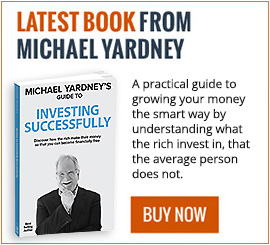There are more interesting articles, commentaries and analyst reports on the Web every week than anyone could read in a month.
Each Saturday morning I like to share some of the ones I’ve read during the week.
The weekend will be over before you know it, so enjoy some weekend reading.
Finding co-owners to buy an Australian house online may be riskier than it looks
It’s no secret we live in a digital world!
Weather it’s shopping, communicating, making business connection or even dating – everything is now online, and it would seem that the property market is no different.
An article on Domain.com.au looks at the risks of looking for co-owners to buy Australian houses online.
Digital platforms are offering people who couldn’t afford a house on their own, the opportunity to divvy up the costs with others.
But co-ownership of real estate can be a risky and potentially costly business.
In an environment of high residential prices where families are becoming a smaller proportion of households, and permanent relationships are giving way to transient and more distant connections, digital platforms for co-ownership are filling an emerging need.
Co-ownership permits a whole range of sharing options.
For example, it allows an occupant to be a part owner in their own home even if they cannot afford to buy the whole thing.
It also permits an investor to take a smaller position as a promise of a better relationship with the tenant.
However, buying or selling a property involves legal, financial, statutory and agency costs that mean that even moving across the road can cost about half a year’s income.
This means that you need to be sure of what you are doing and reasonably confident that you will not be changing your mind about your investment too quickly.
Digital platforms like Kohab are using the legal relationship known as “tenancy in common” to facilitate co-ownership.
It permits the separate parties to have a defined share of the house and to transfer their interests independently.
But this still presents considerable practical risks. Someone wanting to sell their share of a house is likely to find a limited market of other people willing to take over the part ownership, and they are likely to have a weaker negotiating position in selling.
The remaining co-owners of a house also have no control over who the incoming partner will be.
This may limit their preferences in relation to how the property should be managed.
It can make remaining with the investment uncomfortable and lead to even more turnover of ownership and the prospects of sale at a discount.
Shared real estate ownership has been evolving for some time.
The strata title system was introduced over 50 years ago when it became necessary for single buildings to be owned by multiple people.
Company title co-ownership was unpopular because the co-owners did not always agree on how to manage their property.
It was also unpopular because sale of part-interests was difficult and often settled at a discount to true value.
However, it overcame the problems of management and resale that dogged the earlier company title.
This approach used company shares to split ownership of a property between several investors.
Australia was later an innovator in the development of property trusts that applied the company model, but with someone to manage the the shared ownership of complex properties.
These property trusts have blossomed as an investment and are now commonly known by their US name – real estate investment trusts.
These trusts usually focus on commercial buildings where they provide a vehicle for small investors to access property investment in major real estate assets.
Where digital platforms come in
Online applications such as DomaCom or BrickX have brought the trust model online and applied it to smaller properties that are not usually the target of these traditional trusts.
BrickX for example divides its selected investment properties into 10,000 “bricks” and allows investors to buy bricks.
This permits up to 10,000 owners for an individual property.
It also allows small investors to spread their funds across multiple properties to control their risks.
DomaCom follows a different strategy to achieve the same goal of allowing a large number of investors to be involved in individual managed investment properties.
Then there’s new apps like Kohab. Its point of difference is that it operates on a smaller and perhaps more intimate scale.
It does not rely on a crowdfunding approach, but uses its online platform to connect owner/occupiers and investors for the purpose of co-ownership. It does not produce real estate investment trusts, but does facilitate the co-ownership of individual dwellings by more than one owner.
Read the full article here
Sydney listings up, up, up
Things are looking up for Sydney property listings.
This Blog by Pete Wargent shows the statistics.
Sydney stock up
Sydney listings have finally risen from depressed levels seen over recent years.
Sydney now has 34,901 listings, well up from 28,336 a year earlier, according to SQM Research.
Sydney’s listings are up by 23.2 per cent year-on-year.
Read the full article here
Retirement the top priority for property investors
When it comes what’s most important for property investors – retirement seems to top the list.
In this article for Switzer, John McGrath looks how property investors approach their retirement plan.
Setting up a good retirement is the main reason people invest in property, with most believing that superannuation or the pension will not be enough to fund a comfortable life after work, according to new research commissioned by the Australian Institute of Superannuation Trustees (AIST).
I couldn’t agree more.
Real estate investment and retirement planning go hand-in-hand because both are long term goals.
As I’ve said many times before, property investment works best when it’s bought and held.
Compared to other investment vehicles like shares, property is the easiest to understand.
It doesn’t require frequent monitoring and its value changes very slowly.
It’s simply easier.
An investor buying a property in their 30s has decades to let it mature with minimum of fuss.
The rent generally pays most or all of the mortgage and tax offsets help cover any shortfalls.
Plus, with most loans on 25-30 year terms, the property will be close to or fully paid off by the time retirement rolls around.
Investing early in life and holding for 30-40 years means you’ll go through several full growth cycles before retirement, delivering excellent capital growth for you to liquidate or a weekly income for life.
Aside from retirement planning, the research also identified what I believe is an increasingly important motivator for today’s mum and dad investors.
While 64% of investors in the Home Truths survey (conducted for the AIST by Essential Media in Feb/March this year) rated retirement planning as the most important factor in deciding to invest, 39% of investors with kids said creating an asset to pass on was also a crucial part of it.
Further to this, 34% of investors with kids said concerns about their children’s ability to afford their own homes also drove them to invest in property and 29% said providing
somewhere for them to live was also a primary motivator.
We’re seeing this on the ground across the East Coast but particularly in Sydney, where more parents are turning up to opens and auctions with their 20 or 30-something aged children looking to buy.
Sometimes they’re just funding the deposit; other times mum, dad and child are pooling funds to purchase together.
Many parents are buying investment properties close to universities so their kids can live there while studying.
Their child’s need for a home is the primary driver to buy, with the benefits of investment a close secondary factor.
Declining affordability, particularly in Sydney, is prompting parents to change strategy on their pathway to retirement.
They’re no longer solely focused on paying off the family home, going into retirement debt-free and doing a seachange with money left over from the sale of their home to fund the rest of their lives.
Today, they feel they have to act now to set up their kids’ financial futures too.
This trend means more retirees are likely to go into retirement with debt – and will probably have to use superannuation to pay it down.
If we look even further into the future, taking into account declining rates of home ownership across Australia, we’ll eventually see more retirees finishing work without the safety net of owning their own home.
We hear a lot about affordability’s effect on young people but the truth is this problem has ramifications for other generations too.
I can’t emphasise enough the lifelong benefits of buying that first property – whether for investment or first home ownership, as soon as you possibly can.
Read the full article here
Australia’s housing market slowdown explained, in 4 charts
All signs indicate that Australia’s property market is at a slowdown.
So what’s really going on?
An article on Business Insider looks at 4 articles that explain the current state of play.
Australia’s housing market is slowing down, led by the nation’s largest and most expensive city, Sydney.
However, as has been well documented, Australia is not one housing market, but many, with prices in many locations actually moving higher as those in other regions fall.
Indeed, while Australian home prices were flat in March in average weighted terms, according to data released by CoreLogic, prices in regional areas actually increased, as did those in all capital cities aside from Sydney, Melbourne and Adelaide.
And it wasn’t just by location where price divergences were seen, but by dwelling values, too.
As seen in this excellent chart from Westpac Bank, the national slowdown largely reflects a steep reversal in prices in the top end of Australia’s housing market, a performance in stark contrast to the upswing of the price cycle where these properties outperformed.
Source: Westpac Bank
While less-expensive segments of the housing market have also slowed, to date, they still remain in positive territory on an annualised basis.
According to Matthew Hassan, senior economist at Westpac, the recent underperformance of the top end of the market reflects weakness in Sydney and Melbourne.
“The detail shows the epicentre of the [Sydney] slowdown is houses at 3.8%, and particularly those in the upper end of the market at 6.5% over the year,” he says.
As seen in this next chart from Westpac, it’s a similar story in Melbourne with the top end of the market slowing significantly faster than in other major capital cities.
Source: Westpac Bank
However, at the other end of the housing valuation spectrum, annual price growth has held up considerably better over the past year, likely reflecting strong levels of population growth, less affordability constraints and the introduction of stamp duty concessions for first time buyers in New South Wales and Victoria.
This chart from Westpac shows the annual price change for properties in the middle 50% of valuations.
Source: Westpac Bank
And this is the same chart, only for the bottom 25% of property valuations.
Source: Westpac Bank
The charts provide an excellent reminder that while price growth is slowing nationally, it largely reflects weakness in the top end of the market, especially in Sydney and to a lesser degree in Melbourne.
Read the full article here
A Brilliant Sign That Your IQ Is High
Do you know what your IQ is?
It could be higher than you think…
This article from spring.org.uk looks at the sign indicating a high IQ.
This sign of intelligence is what makes society work.
Intelligent people are better at cooperating with others, new research finds.
While personality traits like being generous and conscientious have an effect on cooperation, higher IQ is the main factor that encourages people to work well together.
That is why people with high IQs are so essential: without them society would not work.
People with lower intelligence tend not to use a consistent strategy and fail to consider the consequences of their actions, the researchers also found.
Professor Eugenio Proto, who led the study, said:
“We wanted to explore what factors make us effective social animals.
In other words, what enables us to behave optimally in situations when cooperation is potentially beneficial not only to us, but to our neighbours, people in the same country or who share the same planet.
The research involved participants playing a series of games that test cooperation and how risk is traded against reward.
Professor Proto said:
“People might naturally presume that people who are nice, conscientious and generous are automatically more cooperative.
But, through our research, we find overwhelming support for the idea that intelligence is the primary condition for a socially cohesive, cooperative society.
A good heart and good behaviour have an effect too but it’s transitory and small.
An additional benefit of higher intelligence in our experiment, and likely in real life, is the ability to process information faster, hence to accumulate more extensive experience, and to learn from it.
This scenario can be applied to the workplace, where it’s likely that intelligent people who see the bigger picture and work cooperatively, will ultimately be promoted and financially rewarded.”
Read the full article here












No comments:
Post a Comment